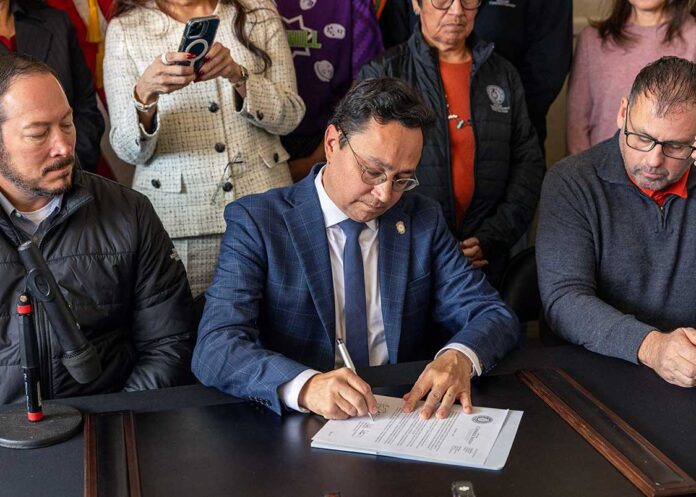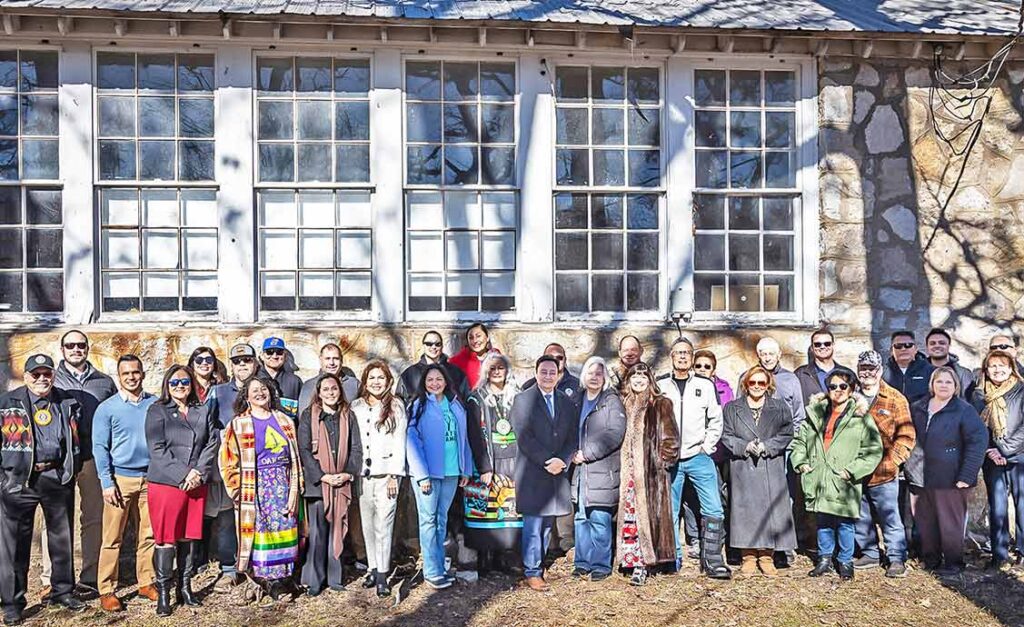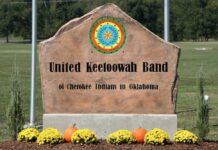
TAHLEQUAH, OK – Cherokee Nation officials gathered with Bureau of Indian Affairs (BIA) regional leaders to celebrate the deed transfers of five separate, historic boarding school-era day school properties located across the tribe’s reservation.
The five properties placed into trust include Ballou Day School in Mayes County; Mulberry Hollow Day School, also known as Rabbit Trap School, in Adair County; Oak Hill-Piney Day School in Delaware County; Oaks Mission Day School, also known as Rocky Ford, in Cherokee County; and Redbird Smith Day School in Sequoyah County. Combined, the five properties represent nearly 84 acres of land.
Each of the five properties had been previously placed into federal ownership in the 1900s. The deed transfers of the properties, each finalized between September and November of 2024, mark 40 years of work between the Cherokee Nation and BIA officials.
“In the name of our ancestors and for the sake of our descendants, we are committed to bringing about a restoration through initiatives like this project with the BIA,” said Cherokee Nation Principal Chief Chuck Hoskin Jr. “These deed transfers have occurred amid the active dialogue we have begun across the nation and world as part of the Cherokee Nation Repatriation Project to restore historical and cultural belongings to Cherokee Nation. Core to this project is partnering with the organizations that hold these significant items to ensure they are returned in a culturally appropriate and mutually beneficial manner. We have much more work to be done on this initiative, but these five boarding school-era day schools being placed into trust is a historic moment.”
During the 2023 State of the Nation address, Cherokee Nation Principal Chief Chuck Hoskin Jr. and Deputy Chief Bryan Warner announced the Cherokee Nation Repatriation Project focused on creating new dialogue with institutions and governments across the country that hold Cherokee cultural patrimony and other stolen or dispossessed cultural materials, properties and archives.
“Moments like this should remind us of just how important the Cherokee Nation Repatriation Project is,” said Deputy Chief Bryan Warner. “We look forward to working with many more organizations in the coming years to protect our storied past.”
American Indian boarding schools were established both on and off Indian reservations in the early centuries of the United States to assimilate Indigenous peoples into American society. By 1928, the Department of the Interior had commissioned a survey, and the resulting report, often referred to as the Meriam Report, was submitted to the Secretary of the Interior highlighting the failures of the federal government to protect Native American rights, health, education, and economic well-being, including through its use of boarding schools.
This report played a significant role in shaping future policies and called for changes to address the abuse occurring in many boarding schools. One result was the Indian Reorganization Act of 1934, which encouraged community day schools to be established and for Native students to attend these schools as an alternative to boarding schools.
“This hasn’t been an easy task, but this is something that everybody wanted,” said Bureau of Indian Affairs Eastern Oklahoma Regional Director Eddie Streater. “Placing land into trust is critical to tribal sovereignty, self-determination, preservation of history and the cultural well-being of tribal members. What was once Cherokee, is Cherokee again, and that means everything to us. The next generation can embrace it and move forward.”

With the five properties now placed into trust – a process wherein the Department of the Interior acquires the title to a land and holds it for the benefit of a tribe or individual tribal members – use of the land will be governed by the Cherokee Nation. Chief Hoskin said the tribe will evaluate ways to use the properties to improve the surrounding communities.
“Here in Oak Hill-Piney, for example, we will develop plans for a new community building under our Housing, Jobs and Sustainable Communities Act,” said Chief Hoskin. “All five of these former BIA day schools are opportunities to build stronger communities.”
The Cherokee Nation has also worked with the U.S. National Park Service, which administers the Native American Graves Protection and Repatriation Act, on recent improvements to that critical piece of legislation. Enacted in 1990, new rules were recently issued following a 2022 review, and the act now requires museums and organizations to obtain informed consent prior to displaying or researching human remains or cultural items that fall under its purview. It also requires museums to communicate inventories and strengthens the authority of tribes in the repatriation process. The act allows museums five years to comply with the new rules.
One example comes from Harvard University’s Peabody Museum. In 2022, the museum issued an apology and pledged to return hair samples taken from 700 Native American children forced to attend government-run boarding schools. The tribe is working with Harvard to recover and appropriately return these remains.
Also, in August of 2024, Cherokee Nation and Gilcrease Museum celebrated the voluntary repatriation of the Cherokee Advocate printing press in Tahlequah. The museum returned the 149-year-old printing press once used to publish the Cherokee Advocate newspaper in the Cherokee language. The press had been owned by the tribe until 1906 when it the press was ordered closed by the federal government, which eventually sold the press. Thomas Gilcrease purchased the press in the 1940s and added to his collection of American art and artifacts. Gilcrease Museum, which is owned by the City of Tulsa and managed by the University of Tulsa, spent a year in the voluntary repatriation effort to get the print press back into the hands of the tribe.














































